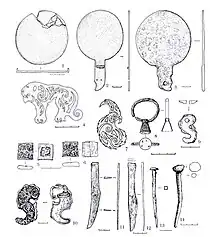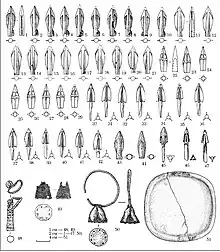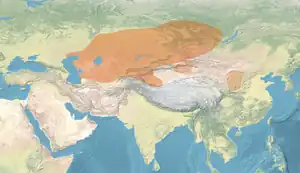Tasmola culture
The Tasmola culture (Kazakh: Тасмола мәдениеті) was an early Iron Age culture during the Saka period (8th to 6th centuries BCE) in central Kazakhstan.[1][2] The Tasmola culture was replaced by the Korgantas culture.[1]
Burials

Everything known about the Tasmola culture originates from the barrows (or kurgans) they built to bury their deceased. The necropoles involve mainly a large barrow and an adjoining small one.[3]
Finds
Characteristic finds are bronze arrowheads, daggers and belt ornaments.[3]
The bronze and golden wares show influences from the preceding Begazy-Dandybai culture.[4]
Genetics


A genetic study published in Nature in May 2018 examined the remains of eight Sakas buried on the central steppe between ca. 900 BC and 500 BC, most of whom were ascribed to the Tasmola culture. The three samples of Y-DNA extracted belonged to the haplogroups R1 (two samples) and E. The eight samples of mtDNA extracted belonged to C4a1a, F1b1, A, H101, C4d, U2e, H10 and U7a4. The Sakas of the central steppe were determined to be of about 56% Western Steppe Herder ancestry and 44% southern Siberian hunter-gatherer ancestry. Hunter-gatherer ancestry was primarily paternal. They displayed a higher amount of southern Siberian hunter-gatherer admixture than other peoples of the Scythian cultures, including other Sakas. It was suggested that the Sakas of the central steppe were a major source of western Eurasian ancestry among the Xiongnu, and that the Huns emerged through the conquest of Sakas by the Xiongnu.[5]
References
- Gnecchi-Ruscone, Guido Alberto; Khussainova (26 March 2021). "Ancient genomic time transect from the Central Asian Steppe unravels the history of the Scythians". Science Advances. 7 (13). doi:10.1126/sciadv.abe4414. ISSN 2375-2548. PMC 7997506.
The Tasmola culture in central and north Kazakhstan is among the earliest major IA nomad warrior cultures emerging (eighth to sixth century BCE)
- Barrows with stone ranges of the Tasmola culture - UNESCO World Heritage Centre
- Tasmola culture
- Megalithic mausolea of the Begazy-Dandybai culture - UNESCO World Heritage Centre
- Damgaard et al. 2018.
Sources
- Damgaard, P. B.; et al. (May 9, 2018). "137 ancient human genomes from across the Eurasian steppes". Nature. Nature Research. 557 (7705): 369–373. doi:10.1038/s41586-018-0094-2. hdl:1887/3202709. PMID 29743675. S2CID 13670282. Retrieved April 11, 2020.
.png.webp)
